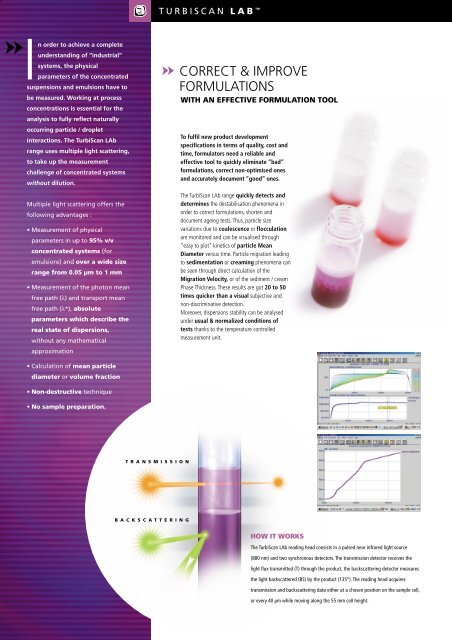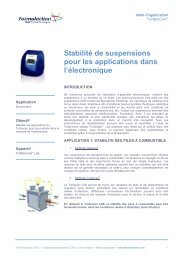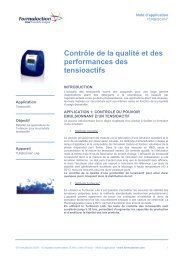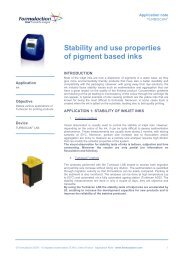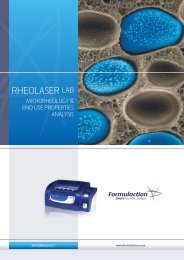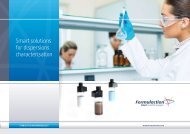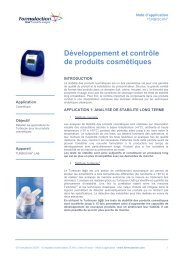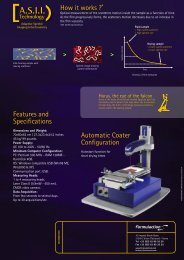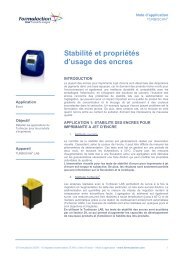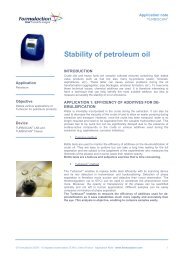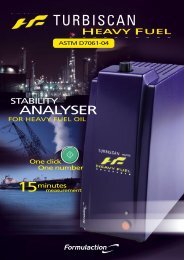TurbiScan Lab brochu.. - Iesmat
TurbiScan Lab brochu.. - Iesmat
TurbiScan Lab brochu.. - Iesmat
You also want an ePaper? Increase the reach of your titles
YUMPU automatically turns print PDFs into web optimized ePapers that Google loves.
In order to achieve a complete<br />
understanding of “industrial”<br />
systems, the physical<br />
parameters of the concentrated<br />
suspensions and emulsions have to<br />
be measured. Working at process<br />
concentrations is essential for the<br />
analysis to fully reflect naturally<br />
occurring particle / droplet<br />
interactions. The <strong>TurbiScan</strong> LAb<br />
range uses multiple light scattering,<br />
to take up the measurement<br />
challenge of concentrated systems<br />
without dilution.<br />
Multiple light scattering offers the<br />
following advantages :<br />
• Measurement of physical<br />
parameters in up to 95% v/v<br />
concentrated systems (for<br />
emulsions) and over a wide size<br />
range from 0.05 µm to 1 mm<br />
• Measurement of the photon mean<br />
free path (λ) and transport mean<br />
free path (λ*), absolute<br />
parameters which describe the<br />
real state of dispersions,<br />
without any mathematical<br />
approximation<br />
• Calculation of mean particle<br />
diameter or volume fraction<br />
• Non-destructive technique<br />
• No sample preparation.<br />
T R A N S M I S S I O N<br />
B A C K S C A T T E R I N G<br />
TURBISCAN LAB <br />
CORRECT & IMPROVE<br />
FORMULATIONS<br />
WITH AN EFFECTIVE FORMULATION TOOL<br />
To fulfil new product development<br />
specifications in terms of quality, cost and<br />
time, formulators need a reliable and<br />
effective tool to quickly eliminate “bad”<br />
formulations, correct non-optimised ones<br />
and accurately document “good” ones.<br />
The <strong>TurbiScan</strong> LAb range quickly detects and<br />
determines the destabilisation phenomena in<br />
order to correct formulations, shorten and<br />
document ageing tests. Thus, particle size<br />
variations due to coalescence or flocculation<br />
are monitored and can be visualised through<br />
“easy to plot” kinetics of particle Mean<br />
Diameter versus time. Particle migration leading<br />
to sedimentation or creaming phenomena can<br />
be seen through direct calculation of the<br />
Migration Velocity, or of the sediment / cream<br />
Phase Thickness. These results are got 20 to 50<br />
times quicker than a visual subjective and<br />
non-discriminative detection.<br />
Moreover, dispersions stability can be analysed<br />
under usual & normalized conditions of<br />
tests thanks to the temperature controlled<br />
measurement unit.<br />
HOW IT WORKS<br />
The <strong>TurbiScan</strong> LAb reading head consists in a pulsed near infrared light source<br />
(880 nm) and two synchronous detectors. The transmission detector receives the<br />
light flux transmitted (T) through the product, the backscattering detector measures<br />
the light backscattered (BS) by the product (135°). The reading head acquires<br />
transmission and backscattering data either at a chosen position on the sample cell,<br />
or every 40 µm while moving along the 55 mm cell height.


